BSBWOR501 Manage Personal Work Priorities & Professional Growth
VerifiedAdded on 2023/05/30
|10
|2116
|479
Homework Assignment
AI Summary
This assignment focuses on managing personal work priorities and professional development, addressing key principles and techniques for performance measurement, self-awareness, and personal behavior. It emphasizes maintaining a healthy work-life balance by setting priorities and boundaries, and discusses the importance of aligning personal goals with organizational objectives. The solution explores various learning styles (visual, aural, verbal, physical) and their impact on employee development, highlighting the effectiveness of creativity, cooperation, and discipline in improving personal performance. It also covers strategies for setting work goals, prioritizing tasks using technology like Google reminders, and developing professional competence through certifications, continuous learning, and networking. The document concludes with the importance of maintaining a competitive edge through adaptability, professional engagement, and community participation.

ASSIGNMENT 2
Paraphrase This Document
Need a fresh take? Get an instant paraphrase of this document with our AI Paraphraser
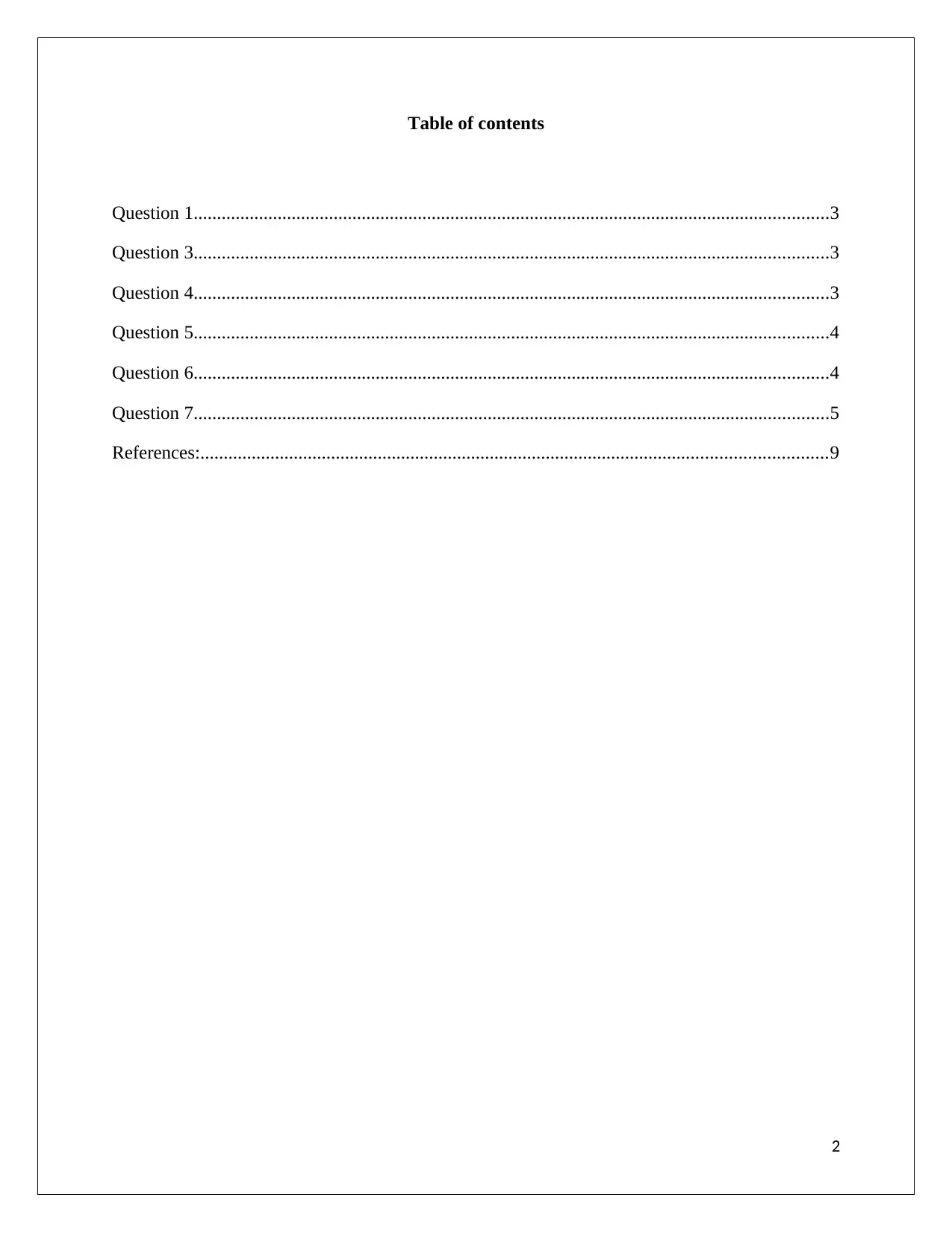
Table of contents
Question 1........................................................................................................................................3
Question 3........................................................................................................................................3
Question 4........................................................................................................................................3
Question 5........................................................................................................................................4
Question 6........................................................................................................................................4
Question 7........................................................................................................................................5
References:......................................................................................................................................9
2
Question 1........................................................................................................................................3
Question 3........................................................................................................................................3
Question 4........................................................................................................................................3
Question 5........................................................................................................................................4
Question 6........................................................................................................................................4
Question 7........................................................................................................................................5
References:......................................................................................................................................9
2
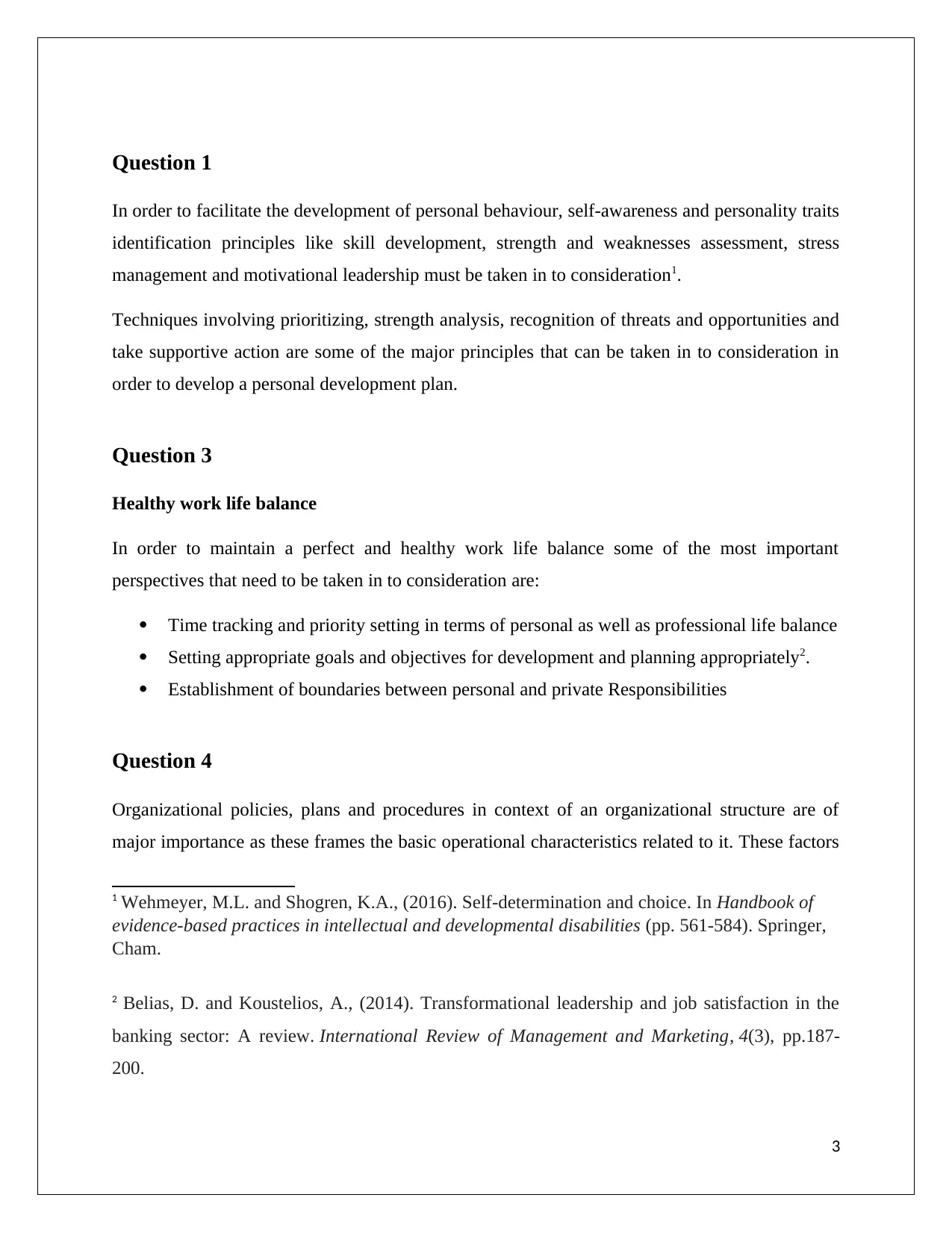
Question 1
In order to facilitate the development of personal behaviour, self-awareness and personality traits
identification principles like skill development, strength and weaknesses assessment, stress
management and motivational leadership must be taken in to consideration1.
Techniques involving prioritizing, strength analysis, recognition of threats and opportunities and
take supportive action are some of the major principles that can be taken in to consideration in
order to develop a personal development plan.
Question 3
Healthy work life balance
In order to maintain a perfect and healthy work life balance some of the most important
perspectives that need to be taken in to consideration are:
Time tracking and priority setting in terms of personal as well as professional life balance
Setting appropriate goals and objectives for development and planning appropriately2.
Establishment of boundaries between personal and private Responsibilities
Question 4
Organizational policies, plans and procedures in context of an organizational structure are of
major importance as these frames the basic operational characteristics related to it. These factors
1 Wehmeyer, M.L. and Shogren, K.A., (2016). Self-determination and choice. In Handbook of
evidence-based practices in intellectual and developmental disabilities (pp. 561-584). Springer,
Cham.
2 Belias, D. and Koustelios, A., (2014). Transformational leadership and job satisfaction in the
banking sector: A review. International Review of Management and Marketing, 4(3), pp.187-
200.
3
In order to facilitate the development of personal behaviour, self-awareness and personality traits
identification principles like skill development, strength and weaknesses assessment, stress
management and motivational leadership must be taken in to consideration1.
Techniques involving prioritizing, strength analysis, recognition of threats and opportunities and
take supportive action are some of the major principles that can be taken in to consideration in
order to develop a personal development plan.
Question 3
Healthy work life balance
In order to maintain a perfect and healthy work life balance some of the most important
perspectives that need to be taken in to consideration are:
Time tracking and priority setting in terms of personal as well as professional life balance
Setting appropriate goals and objectives for development and planning appropriately2.
Establishment of boundaries between personal and private Responsibilities
Question 4
Organizational policies, plans and procedures in context of an organizational structure are of
major importance as these frames the basic operational characteristics related to it. These factors
1 Wehmeyer, M.L. and Shogren, K.A., (2016). Self-determination and choice. In Handbook of
evidence-based practices in intellectual and developmental disabilities (pp. 561-584). Springer,
Cham.
2 Belias, D. and Koustelios, A., (2014). Transformational leadership and job satisfaction in the
banking sector: A review. International Review of Management and Marketing, 4(3), pp.187-
200.
3
⊘ This is a preview!⊘
Do you want full access?
Subscribe today to unlock all pages.

Trusted by 1+ million students worldwide
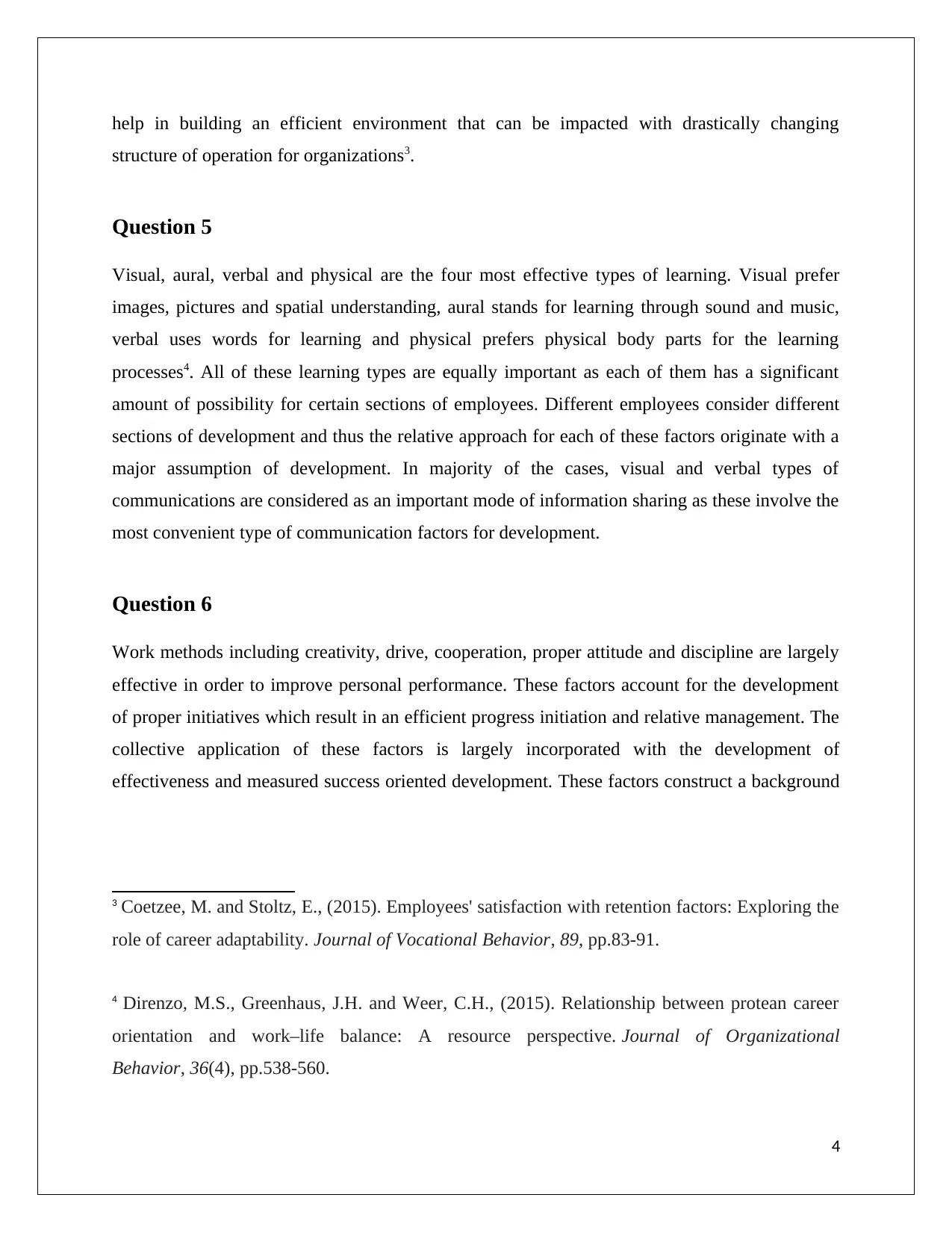
help in building an efficient environment that can be impacted with drastically changing
structure of operation for organizations3.
Question 5
Visual, aural, verbal and physical are the four most effective types of learning. Visual prefer
images, pictures and spatial understanding, aural stands for learning through sound and music,
verbal uses words for learning and physical prefers physical body parts for the learning
processes4. All of these learning types are equally important as each of them has a significant
amount of possibility for certain sections of employees. Different employees consider different
sections of development and thus the relative approach for each of these factors originate with a
major assumption of development. In majority of the cases, visual and verbal types of
communications are considered as an important mode of information sharing as these involve the
most convenient type of communication factors for development.
Question 6
Work methods including creativity, drive, cooperation, proper attitude and discipline are largely
effective in order to improve personal performance. These factors account for the development
of proper initiatives which result in an efficient progress initiation and relative management. The
collective application of these factors is largely incorporated with the development of
effectiveness and measured success oriented development. These factors construct a background
3 Coetzee, M. and Stoltz, E., (2015). Employees' satisfaction with retention factors: Exploring the
role of career adaptability. Journal of Vocational Behavior, 89, pp.83-91.
4 Direnzo, M.S., Greenhaus, J.H. and Weer, C.H., (2015). Relationship between protean career
orientation and work–life balance: A resource perspective. Journal of Organizational
Behavior, 36(4), pp.538-560.
4
structure of operation for organizations3.
Question 5
Visual, aural, verbal and physical are the four most effective types of learning. Visual prefer
images, pictures and spatial understanding, aural stands for learning through sound and music,
verbal uses words for learning and physical prefers physical body parts for the learning
processes4. All of these learning types are equally important as each of them has a significant
amount of possibility for certain sections of employees. Different employees consider different
sections of development and thus the relative approach for each of these factors originate with a
major assumption of development. In majority of the cases, visual and verbal types of
communications are considered as an important mode of information sharing as these involve the
most convenient type of communication factors for development.
Question 6
Work methods including creativity, drive, cooperation, proper attitude and discipline are largely
effective in order to improve personal performance. These factors account for the development
of proper initiatives which result in an efficient progress initiation and relative management. The
collective application of these factors is largely incorporated with the development of
effectiveness and measured success oriented development. These factors construct a background
3 Coetzee, M. and Stoltz, E., (2015). Employees' satisfaction with retention factors: Exploring the
role of career adaptability. Journal of Vocational Behavior, 89, pp.83-91.
4 Direnzo, M.S., Greenhaus, J.H. and Weer, C.H., (2015). Relationship between protean career
orientation and work–life balance: A resource perspective. Journal of Organizational
Behavior, 36(4), pp.538-560.
4
Paraphrase This Document
Need a fresh take? Get an instant paraphrase of this document with our AI Paraphraser
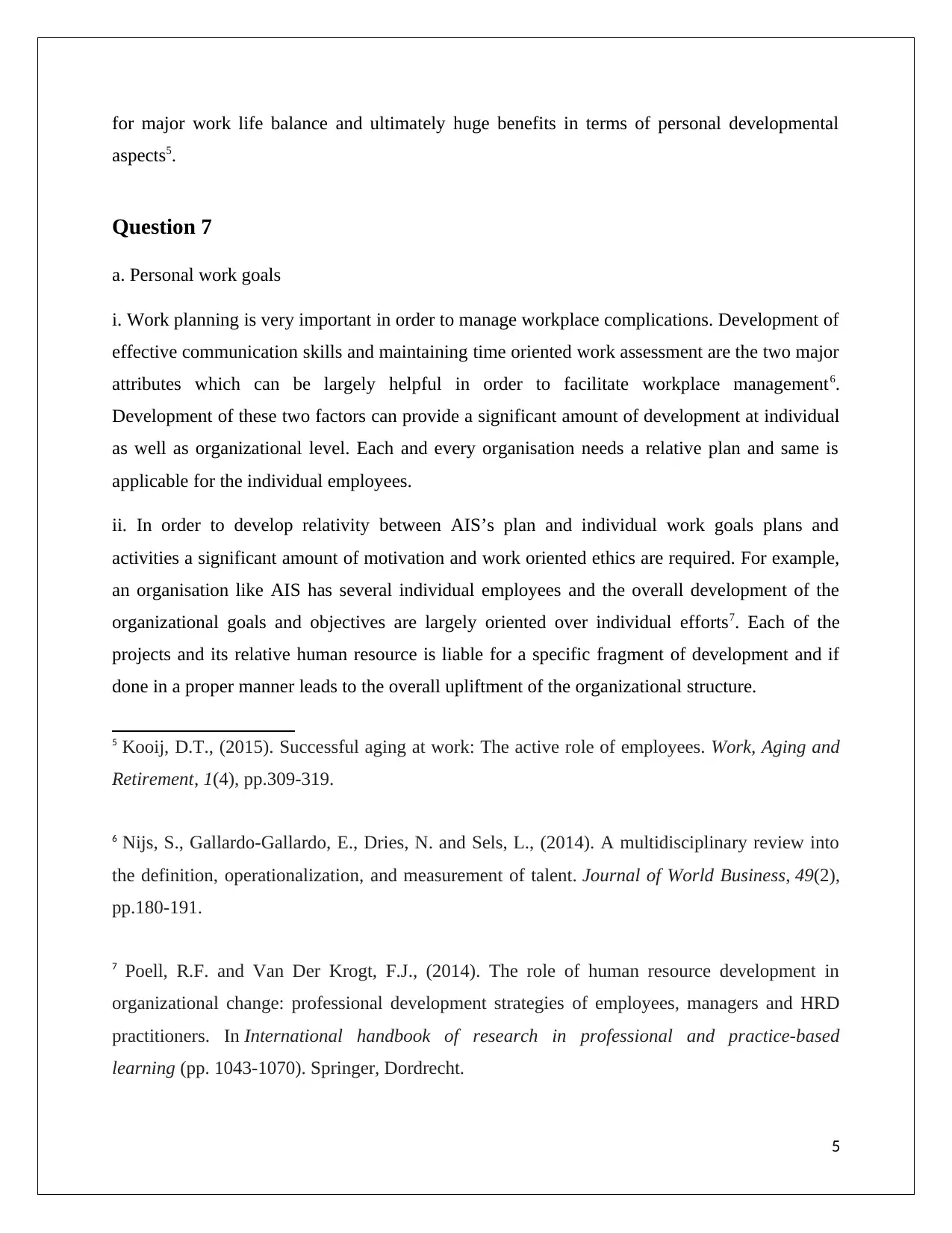
for major work life balance and ultimately huge benefits in terms of personal developmental
aspects5.
Question 7
a. Personal work goals
i. Work planning is very important in order to manage workplace complications. Development of
effective communication skills and maintaining time oriented work assessment are the two major
attributes which can be largely helpful in order to facilitate workplace management6.
Development of these two factors can provide a significant amount of development at individual
as well as organizational level. Each and every organisation needs a relative plan and same is
applicable for the individual employees.
ii. In order to develop relativity between AIS’s plan and individual work goals plans and
activities a significant amount of motivation and work oriented ethics are required. For example,
an organisation like AIS has several individual employees and the overall development of the
organizational goals and objectives are largely oriented over individual efforts7. Each of the
projects and its relative human resource is liable for a specific fragment of development and if
done in a proper manner leads to the overall upliftment of the organizational structure.
5 Kooij, D.T., (2015). Successful aging at work: The active role of employees. Work, Aging and
Retirement, 1(4), pp.309-319.
6 Nijs, S., Gallardo-Gallardo, E., Dries, N. and Sels, L., (2014). A multidisciplinary review into
the definition, operationalization, and measurement of talent. Journal of World Business, 49(2),
pp.180-191.
7 Poell, R.F. and Van Der Krogt, F.J., (2014). The role of human resource development in
organizational change: professional development strategies of employees, managers and HRD
practitioners. In International handbook of research in professional and practice-based
learning (pp. 1043-1070). Springer, Dordrecht.
5
aspects5.
Question 7
a. Personal work goals
i. Work planning is very important in order to manage workplace complications. Development of
effective communication skills and maintaining time oriented work assessment are the two major
attributes which can be largely helpful in order to facilitate workplace management6.
Development of these two factors can provide a significant amount of development at individual
as well as organizational level. Each and every organisation needs a relative plan and same is
applicable for the individual employees.
ii. In order to develop relativity between AIS’s plan and individual work goals plans and
activities a significant amount of motivation and work oriented ethics are required. For example,
an organisation like AIS has several individual employees and the overall development of the
organizational goals and objectives are largely oriented over individual efforts7. Each of the
projects and its relative human resource is liable for a specific fragment of development and if
done in a proper manner leads to the overall upliftment of the organizational structure.
5 Kooij, D.T., (2015). Successful aging at work: The active role of employees. Work, Aging and
Retirement, 1(4), pp.309-319.
6 Nijs, S., Gallardo-Gallardo, E., Dries, N. and Sels, L., (2014). A multidisciplinary review into
the definition, operationalization, and measurement of talent. Journal of World Business, 49(2),
pp.180-191.
7 Poell, R.F. and Van Der Krogt, F.J., (2014). The role of human resource development in
organizational change: professional development strategies of employees, managers and HRD
practitioners. In International handbook of research in professional and practice-based
learning (pp. 1043-1070). Springer, Dordrecht.
5
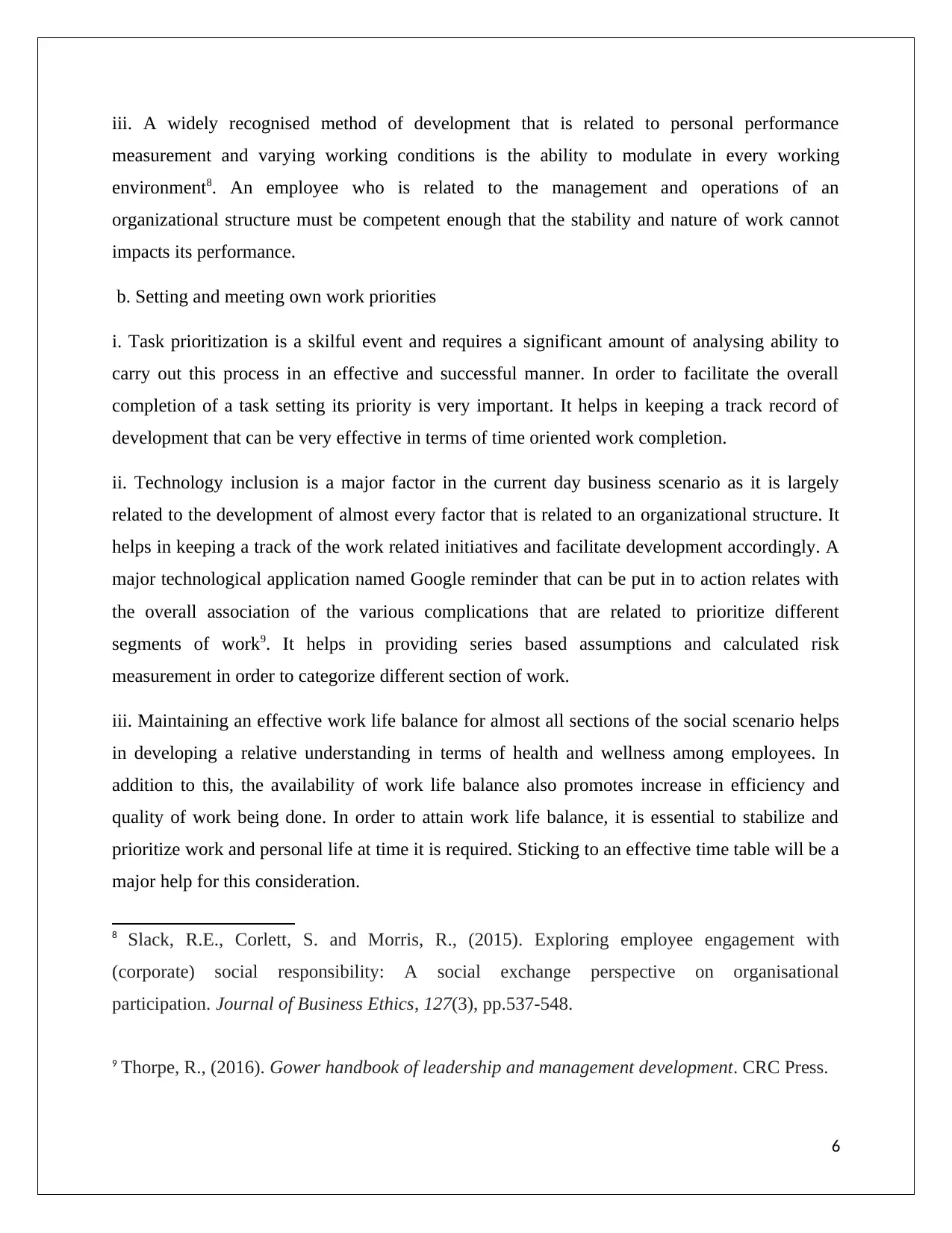
iii. A widely recognised method of development that is related to personal performance
measurement and varying working conditions is the ability to modulate in every working
environment8. An employee who is related to the management and operations of an
organizational structure must be competent enough that the stability and nature of work cannot
impacts its performance.
b. Setting and meeting own work priorities
i. Task prioritization is a skilful event and requires a significant amount of analysing ability to
carry out this process in an effective and successful manner. In order to facilitate the overall
completion of a task setting its priority is very important. It helps in keeping a track record of
development that can be very effective in terms of time oriented work completion.
ii. Technology inclusion is a major factor in the current day business scenario as it is largely
related to the development of almost every factor that is related to an organizational structure. It
helps in keeping a track of the work related initiatives and facilitate development accordingly. A
major technological application named Google reminder that can be put in to action relates with
the overall association of the various complications that are related to prioritize different
segments of work9. It helps in providing series based assumptions and calculated risk
measurement in order to categorize different section of work.
iii. Maintaining an effective work life balance for almost all sections of the social scenario helps
in developing a relative understanding in terms of health and wellness among employees. In
addition to this, the availability of work life balance also promotes increase in efficiency and
quality of work being done. In order to attain work life balance, it is essential to stabilize and
prioritize work and personal life at time it is required. Sticking to an effective time table will be a
major help for this consideration.
8 Slack, R.E., Corlett, S. and Morris, R., (2015). Exploring employee engagement with
(corporate) social responsibility: A social exchange perspective on organisational
participation. Journal of Business Ethics, 127(3), pp.537-548.
9 Thorpe, R., (2016). Gower handbook of leadership and management development. CRC Press.
6
measurement and varying working conditions is the ability to modulate in every working
environment8. An employee who is related to the management and operations of an
organizational structure must be competent enough that the stability and nature of work cannot
impacts its performance.
b. Setting and meeting own work priorities
i. Task prioritization is a skilful event and requires a significant amount of analysing ability to
carry out this process in an effective and successful manner. In order to facilitate the overall
completion of a task setting its priority is very important. It helps in keeping a track record of
development that can be very effective in terms of time oriented work completion.
ii. Technology inclusion is a major factor in the current day business scenario as it is largely
related to the development of almost every factor that is related to an organizational structure. It
helps in keeping a track of the work related initiatives and facilitate development accordingly. A
major technological application named Google reminder that can be put in to action relates with
the overall association of the various complications that are related to prioritize different
segments of work9. It helps in providing series based assumptions and calculated risk
measurement in order to categorize different section of work.
iii. Maintaining an effective work life balance for almost all sections of the social scenario helps
in developing a relative understanding in terms of health and wellness among employees. In
addition to this, the availability of work life balance also promotes increase in efficiency and
quality of work being done. In order to attain work life balance, it is essential to stabilize and
prioritize work and personal life at time it is required. Sticking to an effective time table will be a
major help for this consideration.
8 Slack, R.E., Corlett, S. and Morris, R., (2015). Exploring employee engagement with
(corporate) social responsibility: A social exchange perspective on organisational
participation. Journal of Business Ethics, 127(3), pp.537-548.
9 Thorpe, R., (2016). Gower handbook of leadership and management development. CRC Press.
6
⊘ This is a preview!⊘
Do you want full access?
Subscribe today to unlock all pages.

Trusted by 1+ million students worldwide
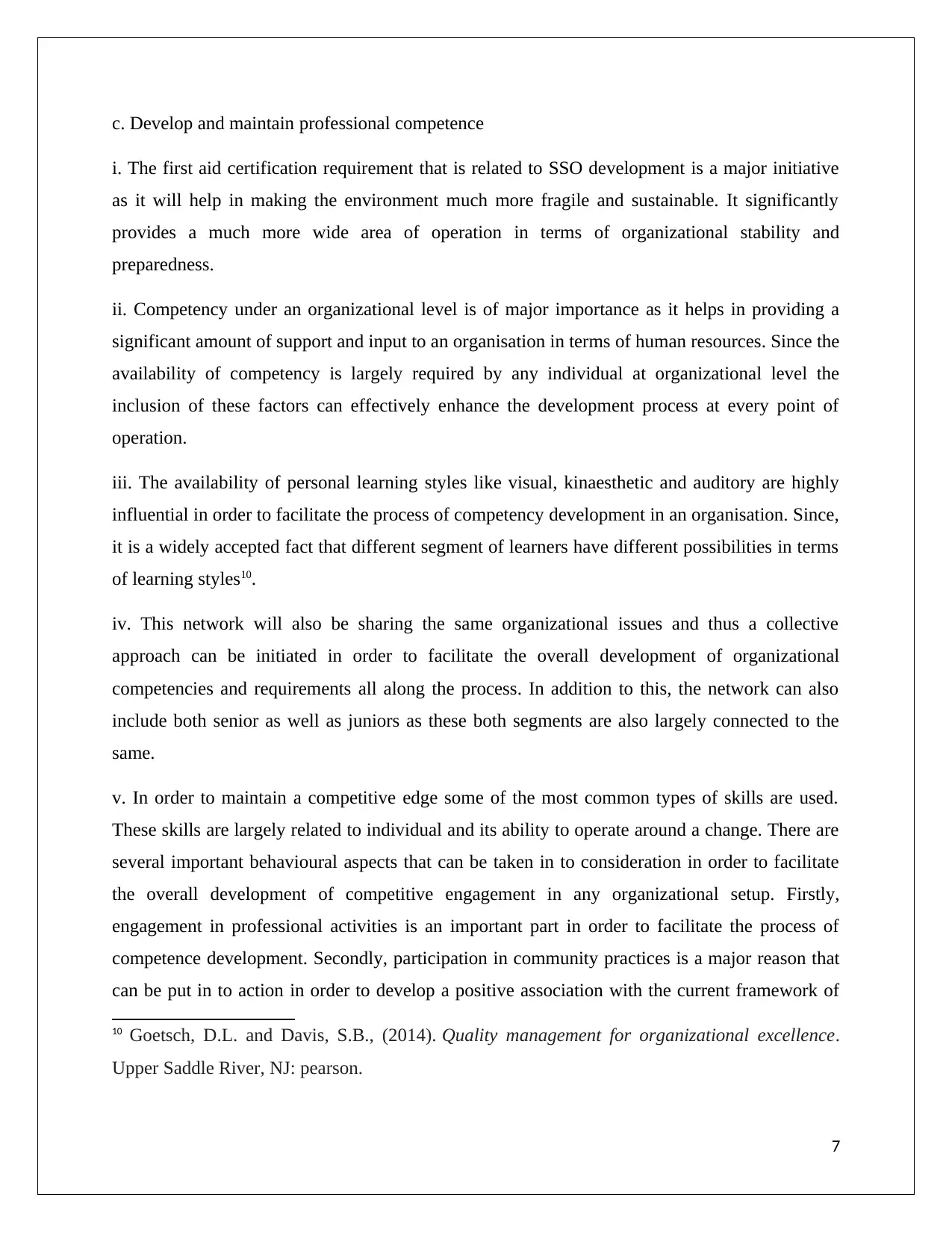
c. Develop and maintain professional competence
i. The first aid certification requirement that is related to SSO development is a major initiative
as it will help in making the environment much more fragile and sustainable. It significantly
provides a much more wide area of operation in terms of organizational stability and
preparedness.
ii. Competency under an organizational level is of major importance as it helps in providing a
significant amount of support and input to an organisation in terms of human resources. Since the
availability of competency is largely required by any individual at organizational level the
inclusion of these factors can effectively enhance the development process at every point of
operation.
iii. The availability of personal learning styles like visual, kinaesthetic and auditory are highly
influential in order to facilitate the process of competency development in an organisation. Since,
it is a widely accepted fact that different segment of learners have different possibilities in terms
of learning styles10.
iv. This network will also be sharing the same organizational issues and thus a collective
approach can be initiated in order to facilitate the overall development of organizational
competencies and requirements all along the process. In addition to this, the network can also
include both senior as well as juniors as these both segments are also largely connected to the
same.
v. In order to maintain a competitive edge some of the most common types of skills are used.
These skills are largely related to individual and its ability to operate around a change. There are
several important behavioural aspects that can be taken in to consideration in order to facilitate
the overall development of competitive engagement in any organizational setup. Firstly,
engagement in professional activities is an important part in order to facilitate the process of
competence development. Secondly, participation in community practices is a major reason that
can be put in to action in order to develop a positive association with the current framework of
10 Goetsch, D.L. and Davis, S.B., (2014). Quality management for organizational excellence.
Upper Saddle River, NJ: pearson.
7
i. The first aid certification requirement that is related to SSO development is a major initiative
as it will help in making the environment much more fragile and sustainable. It significantly
provides a much more wide area of operation in terms of organizational stability and
preparedness.
ii. Competency under an organizational level is of major importance as it helps in providing a
significant amount of support and input to an organisation in terms of human resources. Since the
availability of competency is largely required by any individual at organizational level the
inclusion of these factors can effectively enhance the development process at every point of
operation.
iii. The availability of personal learning styles like visual, kinaesthetic and auditory are highly
influential in order to facilitate the process of competency development in an organisation. Since,
it is a widely accepted fact that different segment of learners have different possibilities in terms
of learning styles10.
iv. This network will also be sharing the same organizational issues and thus a collective
approach can be initiated in order to facilitate the overall development of organizational
competencies and requirements all along the process. In addition to this, the network can also
include both senior as well as juniors as these both segments are also largely connected to the
same.
v. In order to maintain a competitive edge some of the most common types of skills are used.
These skills are largely related to individual and its ability to operate around a change. There are
several important behavioural aspects that can be taken in to consideration in order to facilitate
the overall development of competitive engagement in any organizational setup. Firstly,
engagement in professional activities is an important part in order to facilitate the process of
competence development. Secondly, participation in community practices is a major reason that
can be put in to action in order to develop a positive association with the current framework of
10 Goetsch, D.L. and Davis, S.B., (2014). Quality management for organizational excellence.
Upper Saddle River, NJ: pearson.
7
Paraphrase This Document
Need a fresh take? Get an instant paraphrase of this document with our AI Paraphraser
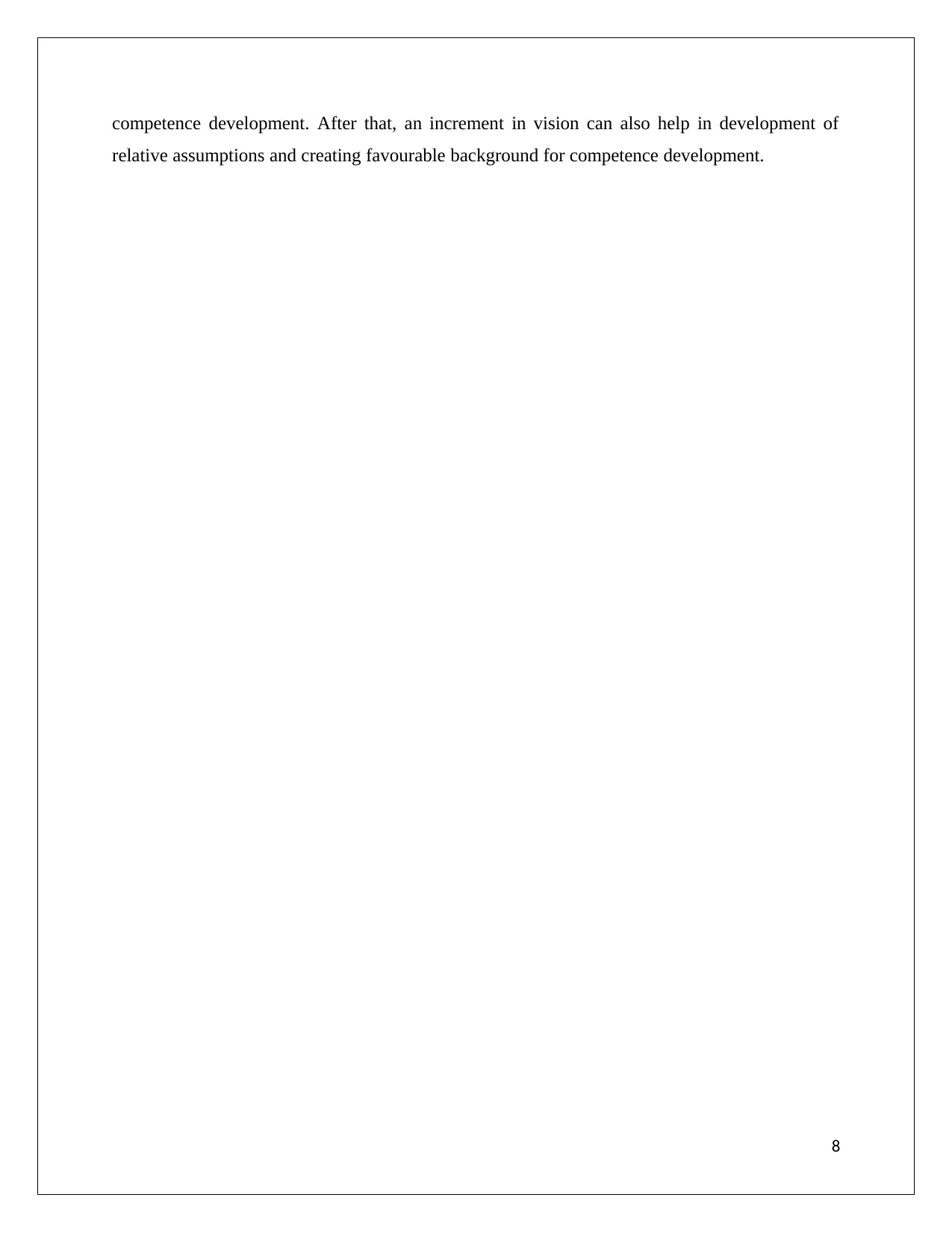
competence development. After that, an increment in vision can also help in development of
relative assumptions and creating favourable background for competence development.
8
relative assumptions and creating favourable background for competence development.
8
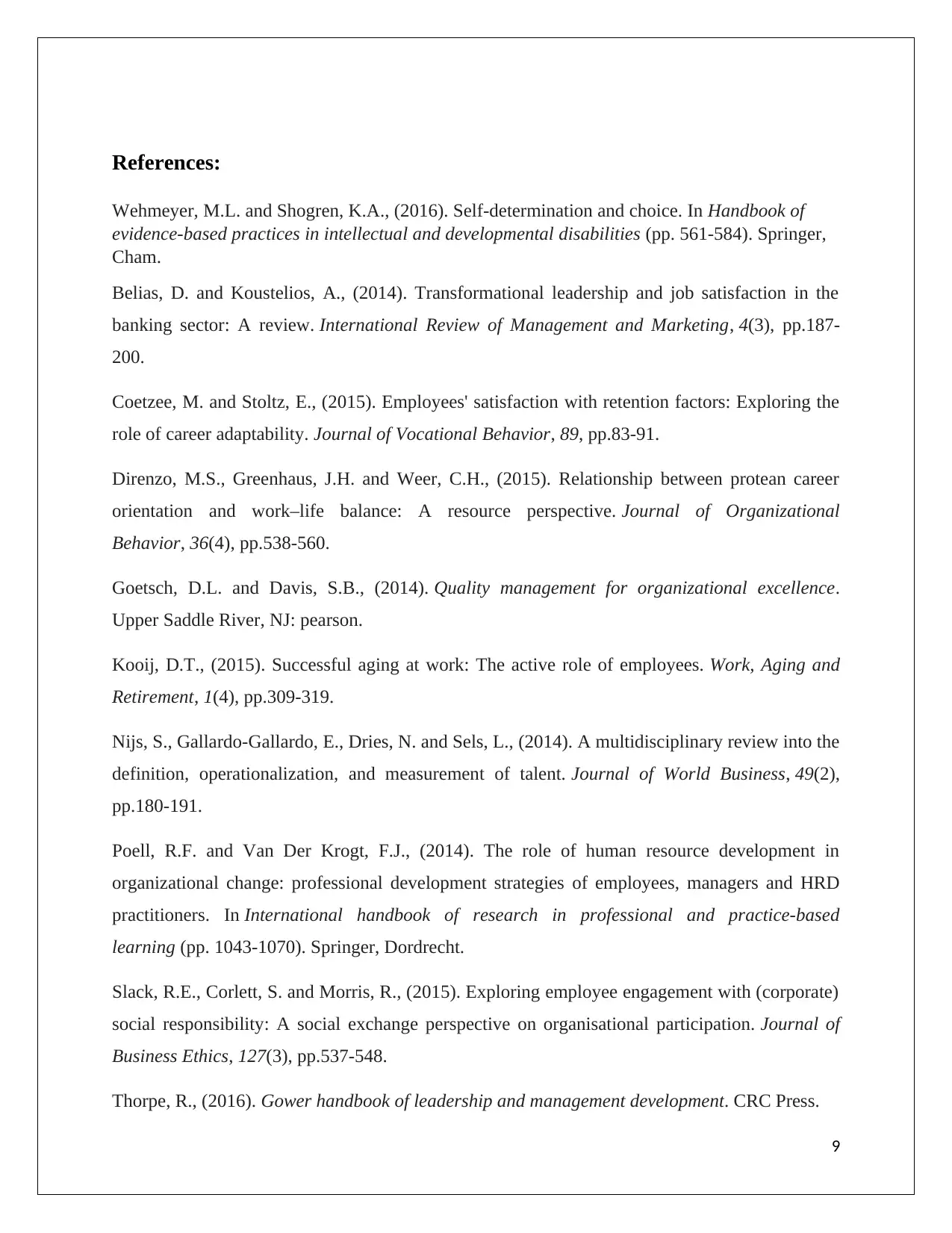
References:
Wehmeyer, M.L. and Shogren, K.A., (2016). Self-determination and choice. In Handbook of
evidence-based practices in intellectual and developmental disabilities (pp. 561-584). Springer,
Cham.
Belias, D. and Koustelios, A., (2014). Transformational leadership and job satisfaction in the
banking sector: A review. International Review of Management and Marketing, 4(3), pp.187-
200.
Coetzee, M. and Stoltz, E., (2015). Employees' satisfaction with retention factors: Exploring the
role of career adaptability. Journal of Vocational Behavior, 89, pp.83-91.
Direnzo, M.S., Greenhaus, J.H. and Weer, C.H., (2015). Relationship between protean career
orientation and work–life balance: A resource perspective. Journal of Organizational
Behavior, 36(4), pp.538-560.
Goetsch, D.L. and Davis, S.B., (2014). Quality management for organizational excellence.
Upper Saddle River, NJ: pearson.
Kooij, D.T., (2015). Successful aging at work: The active role of employees. Work, Aging and
Retirement, 1(4), pp.309-319.
Nijs, S., Gallardo-Gallardo, E., Dries, N. and Sels, L., (2014). A multidisciplinary review into the
definition, operationalization, and measurement of talent. Journal of World Business, 49(2),
pp.180-191.
Poell, R.F. and Van Der Krogt, F.J., (2014). The role of human resource development in
organizational change: professional development strategies of employees, managers and HRD
practitioners. In International handbook of research in professional and practice-based
learning (pp. 1043-1070). Springer, Dordrecht.
Slack, R.E., Corlett, S. and Morris, R., (2015). Exploring employee engagement with (corporate)
social responsibility: A social exchange perspective on organisational participation. Journal of
Business Ethics, 127(3), pp.537-548.
Thorpe, R., (2016). Gower handbook of leadership and management development. CRC Press.
9
Wehmeyer, M.L. and Shogren, K.A., (2016). Self-determination and choice. In Handbook of
evidence-based practices in intellectual and developmental disabilities (pp. 561-584). Springer,
Cham.
Belias, D. and Koustelios, A., (2014). Transformational leadership and job satisfaction in the
banking sector: A review. International Review of Management and Marketing, 4(3), pp.187-
200.
Coetzee, M. and Stoltz, E., (2015). Employees' satisfaction with retention factors: Exploring the
role of career adaptability. Journal of Vocational Behavior, 89, pp.83-91.
Direnzo, M.S., Greenhaus, J.H. and Weer, C.H., (2015). Relationship between protean career
orientation and work–life balance: A resource perspective. Journal of Organizational
Behavior, 36(4), pp.538-560.
Goetsch, D.L. and Davis, S.B., (2014). Quality management for organizational excellence.
Upper Saddle River, NJ: pearson.
Kooij, D.T., (2015). Successful aging at work: The active role of employees. Work, Aging and
Retirement, 1(4), pp.309-319.
Nijs, S., Gallardo-Gallardo, E., Dries, N. and Sels, L., (2014). A multidisciplinary review into the
definition, operationalization, and measurement of talent. Journal of World Business, 49(2),
pp.180-191.
Poell, R.F. and Van Der Krogt, F.J., (2014). The role of human resource development in
organizational change: professional development strategies of employees, managers and HRD
practitioners. In International handbook of research in professional and practice-based
learning (pp. 1043-1070). Springer, Dordrecht.
Slack, R.E., Corlett, S. and Morris, R., (2015). Exploring employee engagement with (corporate)
social responsibility: A social exchange perspective on organisational participation. Journal of
Business Ethics, 127(3), pp.537-548.
Thorpe, R., (2016). Gower handbook of leadership and management development. CRC Press.
9
⊘ This is a preview!⊘
Do you want full access?
Subscribe today to unlock all pages.

Trusted by 1+ million students worldwide

10
1 out of 10
Related Documents
Your All-in-One AI-Powered Toolkit for Academic Success.
+13062052269
info@desklib.com
Available 24*7 on WhatsApp / Email
![[object Object]](/_next/static/media/star-bottom.7253800d.svg)
Unlock your academic potential
Copyright © 2020–2025 A2Z Services. All Rights Reserved. Developed and managed by ZUCOL.





